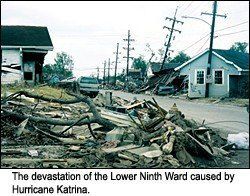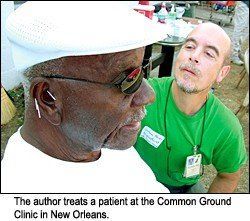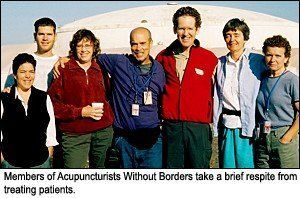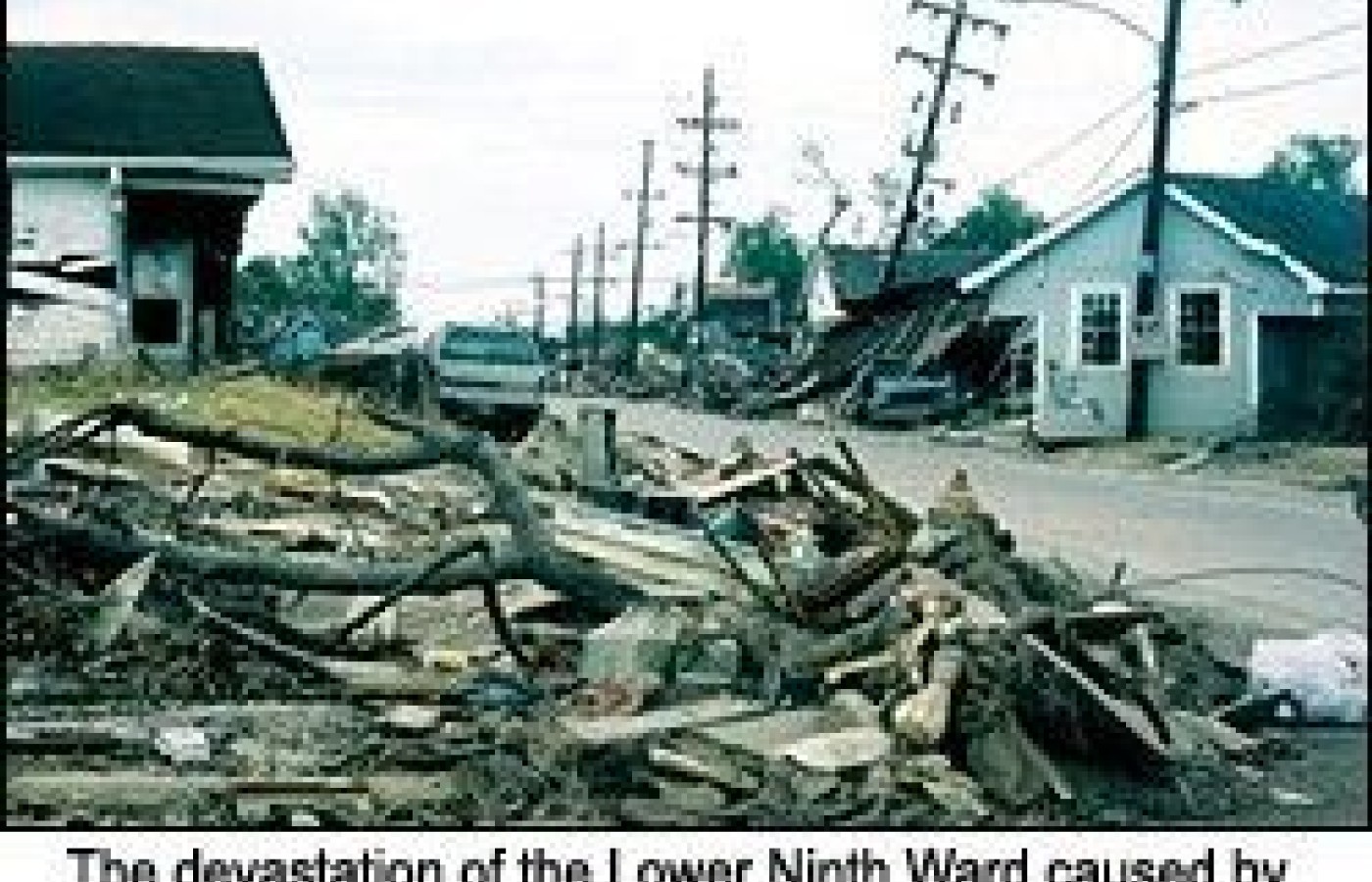Whether you accept it, avoid it or live somewhere in between, insurance coverage has become a defining issue for our profession. Patients increasingly expect to use their benefits, practitioners want to be compensated fairly for their time and expertise, and the system itself remains – at best – fragmented. The encouraging news is that coverage has expanded in meaningful ways. The challenging news is that reimbursement, across the board, remains inadequate.
Acupuncturists Without Borders: Report From the Streets of New Orleans
It has been a dream of Diana Fried, an acupuncturist who lives in New Mexico, to create an organization of acupuncturists that can go to areas of disaster, much like the Red Cross does, to provide acupuncture treatments in situations where it would be appropriate. Once people have food, water and shelter, it is of utmost importance to support the healing process from extraordinary trauma and its many manifestations throughout the body, mind and spirit.
Diana felt compelled to make her dream a reality after the onslaught of Hurricane Katrina on the Gulf Coast. She and a group of other dedicated people began working tirelessly to create a legal not-for-profit organization that was named Acupuncturists Without Borders (AWB). When this core group started putting together the first team of acupuncturists to actually go to Louisiana, I volunteered to be part of it. So, on Oct. 11, 2005, I found myself on a plane on my way to New Orleans, where I met Diana, Sue Larkin from Cape Cod, and Dr. Sue Pollard from Albuquerque, NM.
Through the AWB web site (www.acuwithoutborders.org), acupuncturists from across the U.S. were starting to sign up to volunteer, so our mission was to find venues where our professional services could be offered to evacuees and others who had experienced the trauma of the hurricanes, as well as to the relief workers who were working long hours to help and support the victims. Our treatments were free and available to all who needed them. Once we established venues, the way would be paved for the succeeding groups of AWB volunteers who would arrive after us.

The community-style acupuncture method we use is well-suited to conditions faced in a disaster. We can set up our treatments almost anywhere and can quickly treat large groups of people with minimal supplies and expense. We use the NADA ear protocol, along with body points when appropriate (and within easy reach). The treatments last from 20 minutes to 45 minutes, with people sitting in a chair fully clothed. The effects of the treatment are seen immediately. Many people experience a deep relaxation; many fall asleep. Energetically, one can see the release of the stress in their bodies as they let go of the burdens they carry.
The following is a recounting of some of my experiences treating the victims of Hurricane Katrina in New Orleans. These experiences are told in the present tense, using an informal, diary format.
October 16, 2005 - This is the hardest day. The Lower Ninth Ward is the community in New Orleans where the levee broke and was almost completely underwater. After the waters receded what was left was an ashen landscape of debris and shattered homes. It is devastated, silent, a ruin. Bodies are still being discovered in the wreckage. We set up a clinic at the Red Cross tent and offer treatments to the people gathering there. A woman sits down. She relaxes into the treatment and at the end, asks me, "Where in New Orleans are you from?" I tell her I am from western New York state. She is shocked and asks, "Why are you here in this place?" I say, "To try to help," and she starts crying. I start crying also. We are all silent in the car as we drive through the neighborhood streets that are passable. Later that evening I call my wife, and when I hear her voice, I start weeping. The grief and the loss of these people just wells up in my heart.

October 17 - We are staying in a tent encampment for emergency responders on the grounds of the water treatment plant in the Algiers neighborhood. It is a self-contained base with showers, laundry, and a food service that prepares three meals a day for about 800 people. The administrators of the encampment are grateful that we are there, and we are grateful for the shelter and acceptance. They give us a tent in which to set up a clinic. As I go through the food line, one of the cooks behind the counter who is serving us sees my "acupuncturist" ID badge and says, "My wrists are killing me from preparing so much food all day. Can you help me?" When she gets off her shift, I do a treatment. Next day on the food line she is beaming. "I slept so well and my wrists feel so much better!" I see her the next day and again she is beaming." I slept well again and the wrists are still good!"
October 18 - Our improvised clinic is a row of chairs and a table on the sidewalk. A man sits down. When I ask him what he needs he says, "I haven't cried yet." We begin and the grief comes up. He weeps quietly throughout the treatment. Another man comes dancing down the middle of the street and stops at the clinic where the day before I had treated him. "This acupuncture makes me want to dance. It makes me happy. I couldn't sleep before. I saw so many horrible things in the flood. Dead bodies ... Now I have joy again ... The needles help keep my mind straight. You really fixed me up." I awkwardly reply something like, "Well, you know it's not me, I'm just an instrument," and he shoots back, "Well I don't care, I'm coming back tomorrow and I want you to instrument me."
October 19 - A new team of volunteers has arrived. They hit the ground running, and the day they arrive we are all hard at work throughout the city. To be treating with a group of professionals from all over the country, from varied backgrounds and acupuncture traditions, is remarkable. Yesterday we had never met - today we are treating on the streets together. Although the NADA auricular points are our framework, additionally we all bring our own expertise into the treatment arena: TCM, Five-Element, detox work, Taoist balance method, etc. I am struck by the similarities rather than the differences. Rapport comes first, and I am moved by the compassion, tenderness and sensitivity of my colleagues. And people report feeling better, no matter what acupuncture style they were treated with!
November 18 -- The work that AWB is doing continues with rotating teams of volunteer practitioners. In the five weeks that AWB has been in the New Orleans area, over 1,500 people have been treated in the venues listed below:
- The Cajun Dome, Lafayette, La. (evacuees, Red Cross workers, National Guard, local police, firefighters from all over the U.S.)
- Common Ground Health Clinic - Algiers
- Common Ground Distribution Center - Algiers
- Common Ground Distribution Center in the Ninth Ward
- Washington Square Park
- Mary Queen of Vietnam Church (Vietnamese community)
- St. Anthony's Catholic Church in Baton Rouge (Vietnamese community)
- Public park in Algiers point
- St Bernard Parish (residents and FEMA officials)
- Lower Ninth Ward, Red Cross tent
- U.S. Health Services and staff of The School for Visually Handicapped, Baton Rouge
- Emergency Operations Center, New Orleans
- Covenant House (teens at risk)
- Odyssey House (halfway house)
- Tent City (emergency responders, water and sewer workers, food service workers)
- National Guard in New Orleans
- Monte de Olivos Church, Kenner (Honduran community)
- Animal rescue of New Orleans

About Acupuncturists Without Borders
Acupuncturists Without Borders (AWB) is a nonprofit group that urgently needs donations to continue the important work in New Orleans. Please visit the AWB web site at www.acuwithoutborders.org. Donations can be sent to 37 Kelly Lynn Dr., Sandia Park, NM 87047. To contact AWB, call Robin Beckman at (360) 876-4801.



